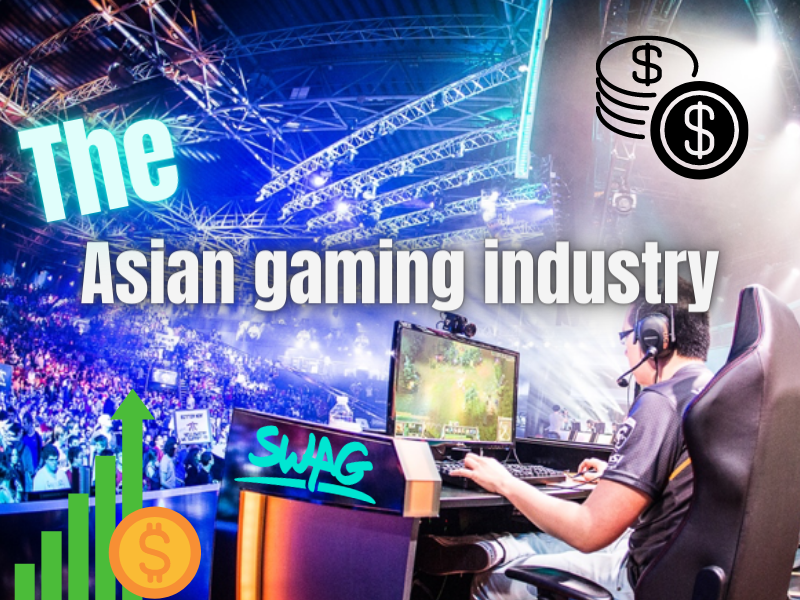Overview of the Asian Gaming Industry.
Let’s start with a detailed overview of the gaming industry in Asia, focusing on its growth, market size, influence, key players, trends, and statistics that showcase Asia’s dominance in the global gaming market:
- Immense Growth and Market Size:
- The gaming industry in Asia has experienced remarkable growth over the past decade, driven by factors such as technological advancements, increasing internet penetration, and a rising young population.
- Asia has become the largest gaming market globally, surpassing North America and Europe. The region’s gaming revenue has witnessed significant growth, reaching billions of dollars annually.
- According to Newzoo, a leading gaming market research firm, Asia-Pacific accounted for approximately 50% of global gaming revenues in 2021.
- Key Players:
- Asia is home to several major players in the gaming industry, contributing to its dominance on the global stage.
- Tencent Holdings (China): Tencent is one of the world’s largest gaming companies, known for its diverse portfolio of games, including popular titles like League of Legends, Honor of Kings, and PUBG Mobile.
- NetEase (China): NetEase is another prominent Chinese gaming company, responsible for successful titles such as Fantasy Westward Journey and Knives Out.
- Sony Interactive Entertainment (Japan): Sony is renowned for its PlayStation consoles and exclusive games, including critically acclaimed franchises like God of War, The Last of Us, and Final Fantasy.
- Nintendo (Japan): Nintendo has a rich history in console gaming, with iconic franchises like Super Mario, The Legend of Zelda, and Pokémon.
- Nexon (South Korea): Nexon is a leading South Korean game developer and publisher, famous for games such as MapleStory, Dungeon Fighter Online, and FIFA Online.
- eSports and Competitive Gaming:
- Asia has emerged as a dominant force in the eSports and competitive gaming scene.
- South Korea, in particular, has been at the forefront of eSports, with a robust infrastructure, professional leagues, and passionate fan bases. Games like StarCraft, League of Legends, and Overwatch have had significant success in South Korea.
- China has also made significant strides in eSports, hosting major tournaments, including The International (Dota 2) and League of Legends World Championship. Chinese teams and players have consistently performed well on the international stage.
- Mobile Gaming Revolution:
- Asia has witnessed a mobile gaming revolution, driven by the affordability and widespread availability of smartphones and internet connectivity.
- Mobile gaming has become a dominant force in the region, with games like PUBG Mobile, Garena Free Fire, and Mobile Legends: Bang Bang capturing millions of players.
- Asian countries, such as China and South Korea, have been instrumental in shaping the mobile gaming landscape with innovative gameplay mechanics, high-quality visuals, and engaging social features.
- Regional Preferences and Cultural Influence:
- Different Asian countries have their gaming preferences and cultural influences that impact the gaming industry.
- South Korea is known for its competitive online gaming culture, with a strong focus on professional gaming and eSports.
- Japan has a rich history in console gaming, producing globally recognized franchises like Super Mario, Pokémon, and Final Fantasy.
- China has a massive domestic market and has become a global powerhouse in both PC and mobile gaming, with its own unique game releases and business models.
- Gaming Technologies and Innovation:
- Asia has been at the forefront of gaming technologies and innovations, including virtual reality (VR), augmented reality (AR), and cloud gaming.
- VR arcades, like the ones in Japan and China, have gained popularity, offering immersive gaming experiences to players.
- Asian companies have also made significant advancements in cloud gaming, allowing players to stream games on various devices without the need for high-end hardware
Explore the thriving eSports scene in Asia.

eSports, or electronic sports, refers to competitive video gaming at a professional level. The eSports scene in Asia has experienced explosive growth and gained massive popularity in recent years. Let’s explore the thriving eSports scene in Asia, including major tournaments, teams, players, success stories, and the rising prize pools:
- Major eSports Tournaments in Asia:
- League of Legends World Championship: Hosted annually by Riot Games, this tournament features the best teams from around the world. Asian teams, particularly those from South Korea and China, have consistently performed well, with South Korean teams winning the championship multiple times.
- The International (Dota 2): Organized by Valve Corporation, The International is renowned for its record-breaking prize pools. Asian teams, including those from China, have dominated the tournament, winning multiple championships.
- Asia-Pacific Predator League: This tournament focuses on the Asia-Pacific region, featuring games like Dota 2 and PlayerUnknown’s Battlegrounds (PUBG). It showcases talent from various Asian countries and promotes regional competition.
- Asian eSports Teams:
- South Korea: South Korea has a storied history in eSports and is home to powerhouse teams across various games. Teams like T1, Gen.G, and DAMWON Gaming have achieved great success in games such as League of Legends, Overwatch, and StarCraft.
- China: China has a robust eSports ecosystem with prominent teams like Invictus Gaming, Top Esports, and FunPlus Phoenix excelling in games such as Dota 2, League of Legends, and Honor of Kings.
- Southeast Asia: Countries like the Philippines, Thailand, and Indonesia have emerging eSports scenes, with teams like TNC Predator, Mineski, and RRQ representing the region in international competitions.
- Successful Asian eSports Players:
- Faker (Lee Sang-hyeok): Faker, a South Korean professional League of Legends player, is considered one of the greatest eSports players of all time. He has achieved multiple world championships and has been a dominant force in the game for years.
- Dendi (Danil Ishutin): Dendi, a Ukrainian-born professional Dota 2 player, rose to prominence while playing for Na’Vi (Natus Vincere). His skill, showmanship, and memorable performances have made him a fan favorite worldwide.
- Xiao8 (Zhang Ning): Xiao8 is a renowned Chinese Dota 2 player and captain. He has led his teams to victory in The International, showcasing his strategic prowess and leadership skills.
- Asian Dominance in International Competitions:
- Asian teams have achieved remarkable success in international eSports competitions. South Korean teams, in particular, have consistently dominated games like StarCraft, League of Legends, and Overwatch.
- Chinese teams have also made their mark in games such as Dota 2 and League of Legends, with multiple victories in major tournaments like The International and League of Legends World Championship.
- Rising Prize Pools:
- eSports prize pools have witnessed substantial growth, attracting more attention and investment. Asian tournaments have contributed significantly to this rise, with events like The International regularly breaking records for the highest prize pool in eSports history.
- The increased prize pools reflect the growing popularity and commercial viability of eSports, attracting top talent, sponsors, and investments.
The success stories of Asian teams dominating international competitions and the rising prize pools in eSports illustrate the increasing influence and recognition of the Asian eSports scene. With the region’s passionate player base, strong infrastructure, and rich gaming culture, Asia continues to be a major force shaping the future of eSports.
The widespread adoption of mobile gaming.

The Mobile Gaming Revolution has transformed the gaming landscape, particularly in Asia, with the widespread adoption of mobile gaming and its impact on the global market. Let’s delve into this revolution, popular Asian mobile games, and the rise of multiplayer mobile games and competitive communities:
- Widespread Adoption in Asia:
- Asia has witnessed a massive surge in mobile gaming, driven by factors such as affordable smartphones, increasing internet accessibility, and a culture that embraces mobile technology.
- The convenience and portability of mobile devices have made gaming accessible to a broader audience, including casual gamers and those who previously had limited access to traditional gaming platforms.
- Impact on the Global Market:
- Asian mobile games have had a significant impact on the global market, both in terms of revenue and cultural influence.
- Games developed in Asia, such as PUBG Mobile (PlayerUnknown’s Battlegrounds), Garena Free Fire, and Honor of Kings (Arena of Valor), have achieved massive success worldwide, attracting millions of players.
- Asian mobile game developers and publishers, including Tencent, NetEase, and Nexon, have become major players in the global gaming industry, contributing to the growth and innovation in mobile gaming.
- Popular Asian Mobile Games:
- PUBG Mobile: PUBG Mobile, developed by PUBG Corporation (a subsidiary of South Korean company Bluehole), is a battle royale game that has gained immense popularity worldwide. It revolutionized the mobile gaming landscape by bringing the large-scale multiplayer experience to smartphones.
- Garena Free Fire: Developed by Garena, a Singapore-based company, Free Fire is another popular battle royale game that has captured a massive player base in Asia and beyond.
- Honor of Kings: Developed by Tencent, Honor of Kings (also known as Arena of Valor) is a multiplayer online battle arena (MOBA) game that has achieved phenomenal success in Asia, particularly in China.
- Mobile Legends: Bang Bang: Developed by Moonton, a Chinese game developer, Mobile Legends is a MOBA game that has gained popularity across Asia, including Southeast Asian countries like Indonesia, the Philippines, and Malaysia.
- Rise of Multiplayer Mobile Games:
- Multiplayer mobile games have become a driving force in the mobile gaming revolution. They foster competitive communities and social interactions among players.
- Games like PUBG Mobile, Free Fire, Honor of Kings, Mobile Legends, and Call of Duty Mobile have popularized the concept of real-time multiplayer gameplay on mobile devices, allowing players to compete and collaborate with others worldwide.
- These games often feature esports tournaments and competitive leagues, further solidifying the competitive nature of mobile gaming and providing opportunities for professional players to showcase their skills.
- Competitive Communities:
- The rise of multiplayer mobile games has led to the formation of passionate and dedicated gaming communities.
- Social features within mobile games, such as chat systems, guilds, and clan systems, enable players to connect, communicate, and form communities with like-minded individuals.
- Mobile gaming communities often organize their own events, tournaments, and online forums to share strategies, tips, and experiences, fostering a sense of camaraderie and competition.
The Mobile Gaming Revolution in Asia has democratized gaming, making it accessible to a broader audience and revolutionizing the gaming landscape. Asian mobile games have made a significant impact on the global market, introducing innovative gameplay experiences and captivating millions of players worldwide. The rise of multiplayer mobile games has not only transformed how people play games but also fostered competitive communities and global connections among gamers.
A closer look at the unique gaming culture in Asia

The gaming culture in Asia is rich, diverse, and unique, shaped by the region’s deep-rooted history, technological advancements, and social factors. Here are several aspects that contribute to the distinctive gaming culture in Asia:
- Competitive Gaming and eSports:
- Asia, particularly South Korea, China, and Japan, has a strong focus on competitive gaming and eSports. Professional gaming is widely recognized and supported, with dedicated leagues, tournaments, and teams.
- The competitive gaming scene in Asia has gained mainstream recognition, with large-scale eSports events drawing massive live and online audiences. Major tournaments like League of Legends World Championship and The International (Dota 2) are celebrated and attract top talent from around the world.
- Internet Cafes (PC Bangs):
- Internet cafes, commonly known as PC Bangs in South Korea and Internet Gaming Centers (IGCs) in other Asian countries, are an integral part of the gaming culture.
- PC Bangs provide affordable access to high-end gaming computers, allowing players to socialize and compete in a shared gaming environment. They have become social hubs where gamers gather, connect, and participate in both casual and competitive gaming.
- Professional Gaming Teams and Players:
- Asia is home to numerous professional gaming teams and players who have achieved legendary status and worldwide recognition.
- South Korean eSports teams, such as T1, Gen.G, and DAMWON Gaming, have dominated in games like League of Legends and Overwatch, contributing to the region’s competitive prowess.
- Famous players like Faker (League of Legends) and Dendi (Dota 2) have become household names, inspiring aspiring gamers and garnering immense fan followings.
- Gaming Cafes and Social Spaces:
- Gaming cafes, also known as “gaming dens” or “gaming houses,” are popular in many Asian countries. These establishments provide a dedicated space for gamers to gather, play, and socialize.
- Gaming cafes often offer a wide selection of games, comfortable gaming setups, and amenities like food and drinks, creating a social and immersive gaming experience.
- Mobile Gaming Culture:
- Mobile gaming has had a profound impact on the gaming culture in Asia. The convenience and accessibility of smartphones have led to a thriving mobile gaming community.
- Mobile games often incorporate social features, fostering interactions between players, such as joining guilds, participating in chat systems, and competing in multiplayer modes.
- In Asia, it is common to see people playing mobile games in various settings, including public transportation, cafes, and social gatherings.
- Game Streaming and Content Creation:
- Asia has a vibrant gaming content creation scene, with many popular streamers and YouTubers showcasing their gameplay and entertaining audiences.
- Streaming platforms like Twitch and local platforms in Asia, such as Douyu and AfreecaTV, attract millions of viewers who tune in to watch live gaming streams, esports events, and gaming-related content.
- Gaming influencers and content creators have a significant impact on the gaming culture, shaping trends, providing game reviews, and fostering a sense of community among viewers.
- Emphasis on Skill and Mastery:
- Asian gaming culture often places a strong emphasis on skill development, strategic thinking, and achieving mastery in games.
- Gamers in Asia dedicate extensive hours to practice, improving their gameplay, and reaching high skill levels. This commitment to mastery is reflected in the success of Asian players in international eSports competitions.
- Gaming Tournaments, Conventions, and Events:
- Asia hosts a plethora of gaming tournaments, conventions, and events that celebrate gaming culture and attract enthusiasts from around the world.
- Events like the Tokyo Game Show (Japan), ChinaJoy (China), and G-Star (South Korea) showcase the latest
Asian Gaming Influencers.

In the vibrant world of gaming, Asian gaming influencers have risen to prominence, captivating audiences worldwide with their talent, entertaining content, and passion for gaming. These influential individuals have not only entertained but also made significant contributions to the gaming community, promoting Asian gaming culture and inspiring aspiring gamers and content creators. Let’s take a closer look at some of these gaming influencers and their impact, with direct links to their YouTube channels for easy access.
- PewDiePie: A household name in the gaming community, PewDiePie’s YouTube channel has amassed over 110 million subscribers. His humorous and engaging gaming content has influenced a generation of gamers worldwide. YouTube Channel
- CarryMinati: Hailing from India, CarryMinati has gained fame through his humorous roasting videos and gaming content. With his energetic commentary, he has built a massive following and become one of India’s most influential gaming influencers. YouTube Channel
- KSI: Known for his music, boxing, and gaming-related content, KSI has a significant Asian fan base. His collaborations with Asian gaming influencers have helped bridge the gap between Western and Asian gaming communities. YouTube Channel
- Markiplier: Markiplier’s Let’s Play videos and engaging personality have garnered him a dedicated following in Asia. Through collaborations with Asian content creators, he has fostered connections between Western and Asian gaming communities. YouTube Channel
- Ranz Kyle: With a passion for gaming and dance, Ranz Kyle, a Filipino YouTuber, has captured the hearts of many fans. His energetic content and entertaining videos have inspired aspiring gamers and content creators in Asia. YouTube Channel
- Gloom: Gloom, a Canadian YouTuber of Asian descent, has a strong following in Asia. Her quirky personality and gaming content have fostered a sense of community among Asian gamers. YouTube Channel
- GONG: Hailing from China, GONG has made a name for himself through his entertaining gaming videos, particularly in popular titles like PUBG. He has become a prominent figure in the Chinese gaming community. YouTube Channel
- Riku: A Japanese YouTuber, Riku focuses on Japanese and Asian gaming titles. His Let’s Play videos, walkthroughs, and game reviews have introduced a global audience to the diverse world of Asian games. YouTube Channel
- PewPew: PewPew, a Thai content creator, has gained popularity through his gaming and DIY videos. His creative and humorous approach has inspired viewers in Asia to explore their gaming passions. YouTube Channel
- Alodia Gosiengfiao: A Filipina cosplayer and gaming influencer, Alodia has made a significant impact on Asian gaming culture. Her gaming-related content, cosplay showcases, and event appearances have inspired many fans. YouTube Channel
Asian gaming influencers have become catalysts in shaping the gaming community, promoting Asian gaming culture, and inspiring a new generation of gamers and content creators. Through their entertaining content, collaborations, and dedication to their craft, these gaming influencers have bridged gaps between different gaming communities, fostering unity and camaraderie. Their contributions continue to shape the gaming landscape and leave a lasting impact on the global gaming community.
The Gaming Industry Challenges and Opportunities
The gaming industry in Asia is thriving, driven by technological advancements, evolving consumer preferences, and a passionate gaming community. However, like any industry, it faces various challenges and opportunities that shape its growth and development. In this paragraph, we will delve into the key challenges, such as game addiction, regulatory concerns, and cultural stereotypes, while also exploring the abundant opportunities, including growth potential, job opportunities, and entrepreneurship within the Asian gaming industry.
- Challenge: Game Addiction:
- Game addiction is a concern that affects individuals of all ages, and Asia is no exception. The immersive nature of gaming and easy accessibility can lead to excessive playtime and potential negative impacts on health, relationships, and overall well-being.
- The challenge lies in creating awareness about responsible gaming practices, promoting balanced lifestyles, and implementing measures to address addiction issues through education, counseling, and support systems.
- Challenge: Regulatory Concerns:
- The gaming industry is subject to regulatory scrutiny in many countries, particularly regarding content, age restrictions, and loot boxes.
- Balancing artistic freedom and protecting vulnerable audiences is crucial. Developing comprehensive and transparent regulations that consider cultural sensitivities and consumer rights is essential for a sustainable and responsible gaming ecosystem.
- Challenge: Cultural Stereotypes:
- Stereotypes and misperceptions surrounding gaming persist in some societies, where gaming may still be stigmatized as unproductive or harmful.
- Educating the public about the positive aspects of gaming, such as its potential for creativity, problem-solving, and social interaction, can help combat cultural biases and promote a more inclusive view of the gaming industry.
- Opportunity: Growth Potential:
- The Asian gaming market has immense growth potential, driven by a large population, increasing disposable income, and improving internet infrastructure.
- The rise of mobile gaming, eSports, and virtual reality (VR) presents opportunities for developers, publishers, and investors to tap into new and expanding markets, both locally and globally.
- Opportunity: Job Opportunities:
- The growth of the gaming industry in Asia has created a demand for skilled professionals in various areas, including game development, design, marketing, esports management, streaming, and content creation.
- Aspiring individuals can pursue careers in these fields, benefiting from the expanding job market and opportunities for professional growth within the dynamic gaming industry.
- Opportunity: Entrepreneurship:
- The gaming industry provides fertile ground for entrepreneurship, as the barriers to entry have decreased with the rise of indie game development, digital distribution platforms, and crowdfunding.
- Asian developers and entrepreneurs can create innovative and culturally relevant games, leveraging their unique perspectives to captivate diverse audiences and carve out a niche in the global gaming market.
While the Asian gaming industry faces challenges such as game addiction, regulatory concerns, and cultural stereotypes, it also presents significant opportunities for growth, job creation, and entrepreneurship. By addressing these challenges through responsible practices, regulatory frameworks, and public awareness, the industry can continue to thrive while ensuring the well-being of gamers and promoting a positive gaming culture. The gaming industry in Asia is poised for further expansion, fostering creativity, technological advancements, and economic opportunities for individuals and businesses alike.
Future Trends: Shaping the Asian Gaming Industry

The Asian gaming industry continues to evolve at a rapid pace, driven by technological advancements, shifting consumer preferences, and innovative developments. Looking ahead, several future trends are poised to shape the landscape of the Asian gaming industry. In this article, we will explore emerging technologies, potential collaborations between Asian and Western gaming companies, and the evolving preferences of Asian gamers.
- Embracing Emerging Technologies:
- Virtual Reality (VR), Augmented Reality (AR), and Mixed Reality (MR) are set to revolutionize the gaming experience in Asia. These immersive technologies have the potential to transport gamers into captivating virtual worlds and enhance gameplay through interactive elements.
- As technology becomes more accessible and affordable, game developers in Asia are expected to create innovative and immersive gaming experiences that cater to the demands of a tech-savvy audience.
- Cross-Cultural Collaborations:
- Collaborations between Asian and Western gaming companies are on the rise, resulting in the fusion of diverse ideas, storytelling techniques, and gameplay mechanics.
- By pooling resources, knowledge, and expertise, these collaborations can lead to the creation of groundbreaking games that appeal to both Asian and global audiences, promoting cultural exchange and diversity within the gaming industry.
- Mobile Gaming Dominance:
- Mobile gaming is expected to maintain its dominance in Asia, driven by the widespread adoption of smartphones and increasing internet connectivity.
- With advancements in hardware capabilities, Asian gamers will enjoy more graphically impressive and immersive gaming experiences on mobile devices, further fueling the growth of the mobile gaming market.
- eSports Expansion:
- eSports, or competitive gaming, is experiencing exponential growth in Asia, with massive tournaments, dedicated leagues, and professional teams gaining popularity.
- The future of eSports in Asia is bright, with increased investments, sponsorships, and infrastructure development to support the growing ecosystem. The establishment of eSports academies and training facilities will nurture the next generation of competitive gamers.
- Rise of Cloud Gaming:
- Cloud gaming is set to revolutionize the way games are played, eliminating the need for powerful hardware and enabling gamers to stream games directly to their devices.
- With the advancement of cloud technologies, Asian gamers will have access to a vast library of games, real-time multiplayer experiences, and seamless cross-platform play, fostering a more inclusive and connected gaming community.
The future of the Asian gaming industry holds great promise, with emerging technologies, cross-cultural collaborations, and evolving preferences shaping its trajectory. As the industry embraces virtual reality, augmented reality, and mixed reality, gamers can look forward to more immersive experiences. Collaborations between Asian and Western gaming companies will give rise to culturally diverse and innovative games. Mobile gaming will continue to dominate, while eSports and cloud gaming will expand, captivating audiences with competitive experiences and accessible gaming options. By staying at the forefront of these trends, the Asian gaming industry will continue to captivate gamers and drive innovation, creating a dynamic and exciting future for gamers across the region and beyond.




